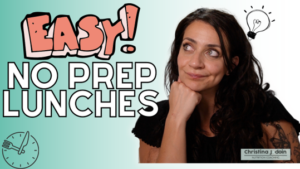I hope you are ready for this!
The most common question I get from nutrition coaching clients when we start working together is: “What do I eat?”
People want to know what to eat so they can stop worrying about making a mistake. They just want to lose weight and not lose their mind over it.
It makes sense, tell me what to eat, I’ll follow the rules, set this on autopilot, and journey to the living lean promise land.
Sounds great right? If you’re a robot this works perfectly. For non-robots like me (and you), this approach is a set up for certified failure.
Here’s why:
While it sounds attractive to have a complete set of instructions that you follow so that you don’t screw anything up, you are not a piece of furniture from IKEA. Your life is more complex than that!
Humans don’t want to be told what to do, we’re inherently resistant to that.
From a practical perspective: you get bored of a meal plan and extremely resentful when you restrict things like pasta, pizza, potatoes or cake at your Aunt’s 90th Birthday Party.
Food delivered to your house from Nutrisystem tastes mostly like crapola.
It ridiculously hard and unnecessarily uncomfortable to go out to eat or go to any event like a tailgate or birthday party and follow rigid food rules
What fails 90-is % of the people who do diets like keto, low carb, intermittent fasting, low fat, weight watchers and Nutrisystem is that it sets up impractical rules around food, requires restriction and it never asks them to explore their relationship with food.
Please don’t diet!
What should you do then?
Plate a balanced meal.
Start with a basic plate concept.
50 ish % of vegetables and fruit
25 ish % protein
25 ish% carbohydrates
About a tablespoon of fat
This plating style has a few different benefits.
First, from a health perspective, it’s a great balance. It’s almost the same as the
Healthy Eating Plate recommended by Harvard University’s School of Public Health.
From a weight-loss perspective, you’re going to get the most amount of fullness from the least amount of calories.
Most importantly, from an eating autonomy standpoint, people usually find that a balance like this gives them flexibility and is effective for whatever their goals are. It sets them up to make choices that fall in line with their commitments in fitness and in the rest of their lives.
It gives people both flexibility in what to eat and a structure for planning their meals.
Sometimes people use the hand method to measure — two fists of vegetables, a fist of carbohydrates, a palm-size of protein, and about your thumb of fat. Something like that. It’s the same idea.
No magic foods, no silly diet rules, we’re just trying to get as close to a healthy, balanced plate as possible. It’s simple and obvious, it’s what we all intuitively know we should do, but we need to just actually do it, because it works.
Learn to do this as consistently as possible, and you’ll basically never need to go on a “diet” again. You can just eat balanced meals and get the portion sizes right automatically.
At this point in time, people are super freaked out about carbohydrates.
Right now, don’t get too stressed out about getting the percentages exactly right. Just try to get in that vicinity. It’s more than just good enough, it’s sustainable and you’ll actually make better progress than if you are stressing and overanalyzing.
If doing this seems uncomfortable to you that’s okay, it is for many people at the start. I trust you’re a good decision-maker. If you don’t think it will work for you, I challenge you to ask yourself why?
No matter what I’m here for you. Have questions on this, fire away I’d love to answer them.
Think you would benefit from some 1 on 1 coaching so we can work through this stuff together, lets chat.
The Don’t Diet Man,
Haylin




